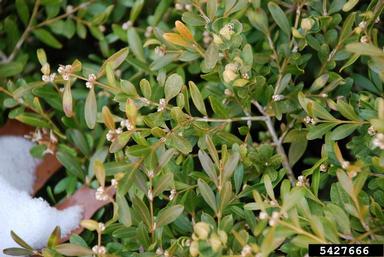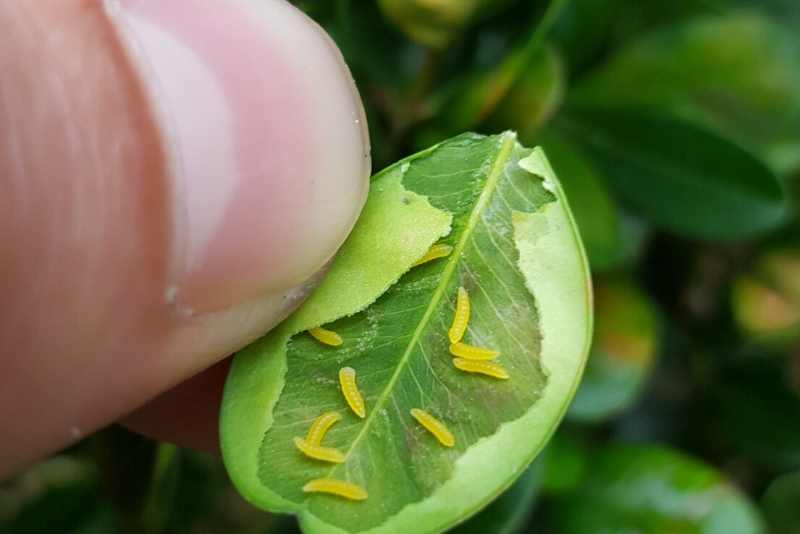
Spring conditions often bring about many issues for boxwoods, posing problems for homeowners throughout the mid-Atlantic. We’ve consulted with our experts, and they’ve devised a guide of the most common threats to boxwoods, along with tips on how to identify them, and what you can do to save them!
Prized for their vibrant green color year-round, boxwoods are a landscape staple in our area. Because of their prevalence and importance to many landscapes, common problems with these woody shrubs can become a major eyesore.
Boxwood Spider Mites
Boxwood spider mites are tiny pests that can infest boxwood plants, causing damage to the foliage. These mites feed on the sap of boxwood leaves, causing speckling on the foliage. Heavy infestations can lead to yellowing, browning, or bronzing of the leaves, as well as premature leaf drop.
Boxwood spider mites are typically very small; they are often red or brown. Cultural practices such as proper watering, pruning, and maintaining plant health can help reduce mite populations.
Boxwood leaves with stippling from spider mite infestation.

Boxwood Psyllids
These tiny pests feed exclusively on boxwoods and can be identified by looking for “cupping” of the leaves or the waxy, white secretions they leave behind.
Although their presence may result in some minor aesthetic issues, the good news is that boxwood psyllids won’t typically harm the overall health of your boxwoods. They only have one generation per year and rarely do enough damage during their lifespans to warrant treatment.
We recommend not treating your boxwoods for these pests as the introduction of unnecessary pesticides can harm beneficial insects that naturally ward off predators.
Waxy, white boxwood psyllid secretions on a Green Velvet boxwood in Northern Virginia

Phytophthora Root Rot
This fungal disease often affects shrubs that are planted in areas with poorly draining soil. Often just referred to as “root rot”, phytophthora can live in moist soil conditions for years. Clay soil can be notoriously poor-draining, which can contribute to your boxwoods developing this fungal issue.
The signs you should look out for:
- Slower growth
- Reduced vigor
- Undersized leaves
- Dieback of foliage
- Drooping or curling leaves
- Browning of foliage
Learn more about phytophthora root rot here.
A boxwood with a yellow patch caused by phytophthora root rot.

Boxwood Leafminer
Boxwood leaf miners are considered the most destructive pests to boxwoods. These small insects resemble mosquitoes but are actually an invasive species that lays eggs inside boxwood leaf tissue.
At this point in the season, the leafminers have entered the adult stage and are no longer causing damage to your shrubs. However, in April or May (the larval and pupal stages), you may have noticed the tell-tale “bubbles” on the leaves.
Learn more about boxwood leafminer here.
Fun fact: if you pop the “bubbles” on the leaves during the larval stage, you can see the larvae inside!

Boxwood Blight
Perhaps the most sinister of all boxwood diseases, boxwood blight is a fungal disease that will eventually kill your boxwoods. The fungus infects all above-ground portions of the shrub.
The signs you should look out for:
- Defoliation/leaf drop, especially if it starts at the bottom of the plant
- Dark leaf spots
- Black lesions/cankers on the green stems
- Browning of the foliage
If your boxwoods have boxwood blight, it’s important to exercise caution. Because of the contagious nature of the disease, it’s important to disinfect tools, gloves, clothing, and hands that have come in contact with an infected boxwood to avoid spreading the disease.
Click here for more information on boxwood blight.
Boxwood in Falls Church, VA with a severe case of boxwood blight.

How to Keep Your Boxwoods Healthy and Happy
- Canopy Protection Program: For fungal issues on boxwoods, prevention is key. We highly recommend having a trained professional monitor your property regularly for signs of disease and pest issues. With this easy program, you’ll have an environmental specialist on your property at least (7) times per year to keep an eye on things. During these visits, your environmental specialist will treat all boxwoods preventatively for fungal issues, which is crucial since treating after infection is oftentimes futile.
- Bio-Stimulants: For stressed or weakened trees and shrubs, we always recommend Bio-Stimulants. We typically suggest two applications per year to help plants recover from disease and insect damage. There are other benefits to Bio-Stimulants; check them out here!
- Anti-desiccants: Boxwoods are susceptible to winter burn, which causes yellowing of the foliage due to moisture leaving the plant at a high rate. Winter burn causes extreme stress to your boxwoods, making them more susceptible to diseases and pests in the spring and summer. Anti-desiccant treatments can help to lock in the moisture and prevent winter burn. Learn more about anti-desiccants and helping winter-burned boxwoods here.
Need some help caring for your boxwoods


